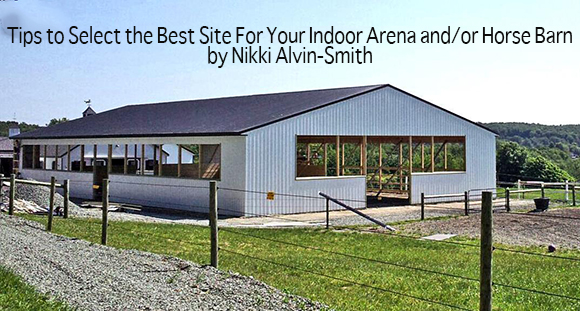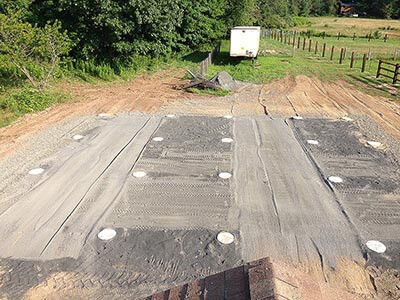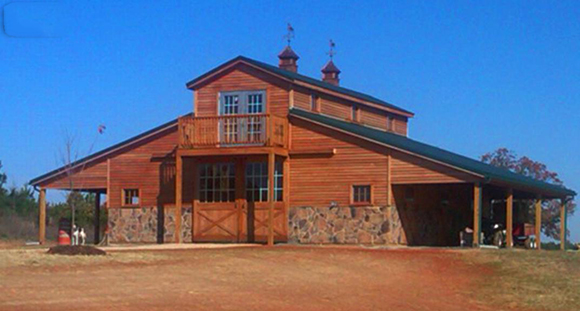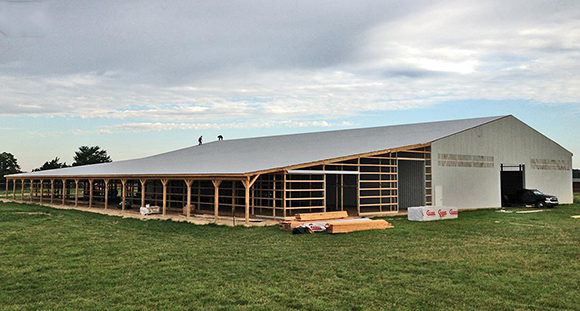Tips to Select the Best Site For Your Indoor Arena and/or Horse Barn
by Nikki Alvin-Smith

You don’t want to hear yourself say, “ I wish I knew then what I know now.” Particularly when it comes to selecting the almost perfect site for your indoor arena and/or horse barn. I say almost because rarely does anyone have the luxury of the perfect site. The considerations are not endless but there are many facets to ponder.
Obviously the ideal property has a huge level open area with well drained soil, no springs to pop up during excavation, no tree lines to avoid and no neighbors close enough to complain about the large building that is on your horizon. The access is splendid for all size vehicles, power and water lines are close by for connection and the land yields beautiful horse grazing green bounty with no rocks or impediments for easy fence ‘planting.’
Life is so straightforward isn’t it? You had no budget constraints when you purchased your dream farm and the land is just perfect for your horse passion to blossom just like the tree-lined driveway you have planned to welcome Spring. Right?
The design of your dream horse farm will be ridiculously easy. You’ll place the indoor toward the center of the property with a connected horse barn. The many beautiful paddocks will be double fenced and encircle three sides of the building. There will be plenty of parking in front of the structure and room to drive easily all the way around. Your manure will be handily disposed of through the back of the building, composted or spread. Your hay will be stored in a separate structure for fire safety. There will be superb air flow through the aisle way and the indoor in the summer as you will be able to face the building in the perfect direction to catch the summer breezes through the aisle way. There will be no snow or ice to worry about so proximity to the road will not be an issue. Your heating system will be solar driven. And the sun will shine brightly everyday. Yeah. O.K. You are dreaming. Not that there is anything wrong with dreaming and dreams do become reality if you work hard.
The All Important Design Aspect
It is important to work with an experienced company when building an equestrian property because their experience can save you a lot of heartache. You need to set a realistic budget for your build and have a clear understanding of what needs you have now and also what needs you may have in the future for the use of the building(s). The design may need to be adjusted to accommodate the actual lay of the land on your property. Compromises are in your future, but do be careful which ones you make!
Rules and Regulations
For the most part rules and regulations exist to protect you from making errant judgments concerning safety and environmental impact.
Check with your local zoning officer for any variances you may need to build, and obtain necessary permits and licenses. Distance to neighbors property lines, driveways, rights of access, distance to protected wet lands all have to be strictly followed and you do want to adhere to these requirements.
We checked in with Mike Rinier, Senior Project Manager at Horizon Structures L.L.C. based in Atglen, Pennsylvania. Horizon Structures is well known for their Amish made pre-fabricated barns and barn kits, and also offer Amish built indoor arenas. Mike heads up the program so we asked him what the most common mistake people make when selecting a site is, based on his experience.
“ A lot of customers have to deal with set backs from fencing or neighboring properties of wetlands. Site locations between trees and hard to access spaces make deliveries tough on us but we do our best with handling equipment and have some very experienced drivers on staff.”
An experienced and professional building company will also provide properly executed plans for your Building Inspector and Zoning Compliance Officer, including truss and building designs that are certified by a professional licensed engineer and constructed for snow load in your area.
On the Level
The more level the site you begin with the cheaper it is to excavate as there is less machine time needed to cut and fill. You may not have much experience if any working with an excavation contractor and it is important that the contractor understands that the site must be truly level and that any drainage issues are addressed before the build is completed.
When we built our indoor arena the excavator had lots of experience and some very fancy equipment that could tell the operator of the bulldozer exactly how level the work was he was doing through a laser that reported through a visual on the front blade. The 190 feet x 70 feet building plus 12 foot apron all the way around was installed to within one inch of level. Impressive. Be certain to add the necessary materials that will be compacted for a firm surface. If you are building an indoor it is a good idea to look at the footing you will need i.e. rubber based (frankly I do not recommend rubber products especially in inside applications as it can breakdown and has been proven to enter both the rider and horse’s lungs), sand or natural product mixes. If you are building a barn consider compacted stone dust on the base, where concrete can be added later in the stalls. Mats can be added over stone dust too. Consider also drainage for the stalls. If adding a drain to each stall than that water must be directed away from the building in a manner that meets code requirements for your area.
A professional company will help you by providing properly executed plans and instructions for both the excavator and the town building department and some companies will go the extra step and liaise directly with your contractor so nothing is ‘lost in translation.’ Horizon Structures provides detailed instructions on all their builds. Whether it is a kit you put together yourself, a modular horse barn they bring in and put together on site in one to three days (miraculous!) or an indoor arena construction undertaken by their Amish carpenters on site.
“ We will work with excavators and site preparation companies to ensure they are following our plans correctly and items are prepared as required,” explained Mike Rinier.
When choosing your site another key to keeping your costs down is to try and stay away from rocky areas or areas with a heavy concentration of moisture in the ground. Mike Rinier advised, “ Do your research with a site plan. You may even do soil capacity tests to know what type of footer or footers may be required. The type of barn you choose will also affect site costs as well.” So choose wisely based on the topography of your property.
If there was water there before the build there will be water there afterward unless something is done to effect good drainage. I have given clinics in the Spring months worldwide where the indoor arena has developed puddles, even small squishy ponds. At other locations the outside track is permanently wet due to run off from the roof not being taken away in correct guttering and drainage systems. This is a major problem in the winter as if it freezes it quickly becomes an icy track. It is always best and less expensive to address water issues before and during the build and not leave them to afterward. Evidence of underwater springs can usually be discovered in the drier months but may not arise until the ground is disturbed. If you see water, take remedial action in the early stages before the build!
You should also bear in mind that a level area at the base of a hill is subject to run-off from that hill so diversion of that run-off are essential. You can address this by building up the base of the site with appropriate materials properly compacted. Depending on the scale of the backfill it may be necessary to make the area level with additional materials and leave the site for a period of time for Mother Nature to exact her own method of compaction through rain and time spent, before doing a final level off for the big build.

If you are including a wash stall in your building be sure to ascertain what the local building code requires for disposal of the water. The exit pipe from the stall running to daylight is ideal but in some areas code does not allow this option. Similarly if adding a bathroom then sewer exit and connection as well as water input connection must be considered in the site plan.
Let the Sun and Wind Offer You Direction
The direction of the sun is important for both light and warmth and should factor into the site decision of your build. Do you want the sun to rise and then move over the roof of the building during the day and set the other side? It is a good option in regard to even light and keeps the sun glare out of the building during the hottest parts of a hot summer day. However, your site may not facilitate this. The addition of solar panels to a barn or indoor is an option to consider and there may be grants in your area that are available to help defray the initial expense. In which case you would want to site the building to catch the sun’s rays appropriately.
The direction of the prevailing winds should also be considered. If your barn design offers Dutch doors to the outside then while you may have an overhang to protect the horses from rain and sun the placement of the building will affect the light and the air flow through the aisle. Bear in mind that the welcome cooling effect of the summer breeze through the aisle may translate to a howling wind tunnel in the winter months. Large sliding doors on an indoor arena can become giant sails on a windy day and precautions should be taken to have them either bolted open or bolted shut in high wind. Careful directional placement of your building can reduce the risks of these doors becoming unwieldy to handle in poor weather.
If you are in an area that receives significant snowfall consider placing the entrances at the gable ends of the indoor as well as the sides, as in winter the snow banks will obliterate the side exit option. A large building such as an indoor arena has a massive roof surface area and gutters and drainage around the base of the building must be carefully considered to remove the water away from the building.
These factors will also affect how you place run in sheds for the pastures. A run in shed should always have its back to the prevailing wind and not be located at the lowest part of the pasture where water will constantly drain into it, and if possible add some gravel through gateways and in front and under the shed to keep these area from becoming muddy.

Vehicular Access and Services
If you site your building far from the road then it will be more expensive to bring electric, water (unless you can drill a well), to service the building and also impact the snow removal costs.
Bringing in electric to the building is hopefully simple if the road service is handily placed. It is a good idea to have a separate meter for the barn/indoor if you are operating it as a business, from both a billing standpoint and in case you want to offer the facility for lease to a trainer at a later time. If you are installing indoor lighting the utility company can be a super resource in aiding you in finding energy efficient lighting fixtures and some companies offer grants to help defray these costs too.
You should also anticipate vehicular access that will need to accommodate large vehicles such as tractor-trailers, horse trailers, hay trailers etc. If you plan to use your facility for clinics or lessons then allow space for parking. During the build of a large structure you must also consider the access for the trusses and building material deliveries.
Maintenance
You will need a tractor or some type of hauling equipment for manure, a harrow for the arena and also consider how and where you are going to dispose of the manure. You can set up a concrete bunker (not too close to the barn because of the flies/insect issue and smell but also not too far away for winter use). The advantage of this is you can compost it and then spread it at a later date over the fields or garden. One innovative barn I know sells their manure to a large supermarket. The company supplies the trailer for its deposit and then picks it up and delivers it for use at their vegetable farm. Recycling is always good!
This equipment will also require some kind of storage.

Horses Love Grass
Where are you planning to place your paddocks? Given that they are not already in place you have to consider that you do not want to be walking horses long distances for turn out and whether you are setting up a horse breeding operation and will be leading mares and foals in and out, or have boarders visiting, no-one wants to be taking extensive walks in all weathers just to fetch their horses. It is also a sensible idea to leave a swath of grass (i.e. double fence) between fence lines so horses cannot reach out to each other and argue over the fence. This can result in damage to both the horses and the fences.
Keeping the pastures close to the barn will also allow a less expensive provision of running water to the troughs in the fields. You will probably want to drill a well for the barn’s exclusive use to service both water in the barn, and the bathroom facility you will surely want to have there. If possible use a Pex product (a plastic pipe that expands if it freezes) versus copper where you can.
Security
This is an issue that is easily overlooked. Placement of the barn or indoor arena beside, behind or in good visual distance from your home provides a layer of security as you will see, (or add surveillance systems to record) every vehicle that comes and goes up the driveway. The downside is, you will see and hear every vehicle that comes up the driveway! So be aware that security and privacy are intertwined and that what might work for you now may not work in the future if you decide you want to lease out the equestrian portion of your property. Personally I have found the addition of a security system is relatively inexpensive and provides real peace of mind.
Proximity of the building to your home should also take into consideration the noise, smells, bugs and rodents, fire hazard and other impacts that having animals close to the home can bring.
In conclusion I would advise taking time to do your own research for your individual needs. Seek the advice of reputable professional companies and other trainers and professionals in the equestrian world.
Catskill Horse magazine is looking forward to an ‘Up Close and Personal’ chat with Boyd later this month and congratulates Boyd Martin on his 7th place showing at Rolex 2017 a few days ago with his awesome Irish sport horse Cracker Jack. Catskill Horse will bring you lots more sage advice on the topic of horse barn and indoor riding arena designs and options directly from the horse’s mouth next month (well O.K. not the horse’s mouth but close).
Boyd Martin, Olympic U.S.A. Eventing Team competitor and a very experienced horseman endorses Horizon Structures L.L.C.. When Boyd’s beautiful Windurra Farm suffered a major fire and he needed new buildings it was to Horizon that he turned for help and he is an advocate of the Horizon brand. Thanks to Mike Rinier, Senior Project Manager at Horizon Structures for his most valuable input for this article.
As I like to say, “ You don’t know what you don’t know.” My job is to bring you that knowledge that you may not have, to help you make the best decisions in your life with horses for both your human and equine families.


